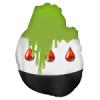-
Posts
594 -
Joined
-
Last visited
Content Type
Profiles
Forums
Events
Posts posted by khaled
-
-
but in the end, this solution does not solve the main problem
saving space .. no,
0 = __
1 = {}
2 = {}{}
3 = {}{}{}
4 = {}{}{}{}
5 = {}{}{}{}{}
6 = {}{}{}{}{}{}
7 = {}{}{}{}{}{}{}
8 = {}{}{}{}{}{}{}{}
9 = {}{}{}{}{}{}{}{}{}
i think i should waste time on more beneficiary ...
0 -
i did read your post,
and if you really read my second post, you'd realize that i started a new idea ...
0 -
so we have, density 14.5 * 10³kg m³
and, Density = mass/volume
so, mass = density * volume ..and.. volume = mass / density
... mass = 14.5 * 10³ * volume ..&.. volume = mass / 14.5 * 10³
UNIT mass = 14.5 * 10³ * 1 kg ..for volume = 14.5 * 10³ m³
UNIT volume = 1 m³ / (14.5 * 10³) = 6.8965517241379310344827586206897e-5
UNIT volume (round) = 6.9
but the question is, how did you estimated the density in the first place,
.. what are you working on, explain your geometrical work space ...
0 -
geometric representation can let you notice possible relations easily,
geometric representation allows transformation,scaling,..etc
sometimes translating one formula into different field expand its enhancement scope,
0 -
it's true that if x = 3y + 5 then,
1. change sides
x = 3y + 5
y = x/3 - 5/3
2. validation
x = 3(x/3 - 5/3) + 5 = 3x/3 - 3*5/3 + 5 = x -5+5
y = (3y + 5)/3 - 5/3 = 3y/3 + 5/3 - 5/3 = y +5-5 = y
0 -
also, let's not forget the possibility of inserting the pi value as fraction into the formula,
for example,
formula: (X + 2[math]X^2{}[/math]) = r
Result = [math]r^2{}[/math] * pi
A: r^2 * (22/7)
B: (X + 2 X^2) * (X + 2 X^2) * (22/7) = (X^2 + 4 X^3 + 4 X^4) * (22/7)
....... = (22 X^2 / 7) + (88 X^3 / 7) + (88 X^4 / 7)
i guess that such process can give better solutions to particular formula
0 -
when we want to tell the computer "for example" to do
calculation like calculating the circle's area,
we may give the following instruction in different versions,
A: Result = [math]r^2{}[/math] * 3.14
B: Result = [math]r^2{}[/math] * 3.1416
C: Result = [math]r^2{}[/math] * 3.14159265
example, input: r = 100000
A: Result = 31400000000
B: Result = 31416000000
C: Result = 31415926500
but yet when we go with real numbers, it start to be worse ...
so the best solution would to be,
let the machine shows you the best it can do !
this means, let the computer do the division ...
and this would be my version of Circle Area Calc .. in C,
long double Circle_Area ( double r ) { double pi = (double)22.0/(double)7.0; long double Result = r * r * pi; return Result; }0 -
irrational numbers, with continues non-repeating decimal representation,
we round the value for use,
0 -
here is a way to make this theory fits for real numbers,
i just thought of it,
n > 0
0 = ..{ }
1 = { { } }
2 = { { }, {{}} }
3 = { { }, {{},{{}}} }
4 = { { }, {{},{{},{{}}}} }
guess you notice that there is always a single empty set at the beginning of the global set
so, we can use it to define precision as follows,
note: i used ,{} to distinguish 0 from 1 ...
0.0 = { }
0.1 = { ,{} }
0.2 = { ,{},{} }
0.03 = { ,{ {},{},{} } }
0.004 = { ,{{ {},{},{},{} }}
example:
3.1235 = { { {}, { {},{}, { {},{},{}, { {},{},{},{},{} }}}}, {{},{{}}} }
................. DECIMAL ..................... INTEGER ....
so degree of precision is specified in levels of { }'s into the single set
PS, i should get a certification for this, you know
0 -
the integral logo is my vote,
<logo> [ .l` f(n) ]
ScienceForums.Net
0



procedure to procedure
in Mathematics
Posted
using an algorithm to generate a picture is not useful, pictures we know are no pattern
but, chaos algorithm is good to simulate cosmic unreachable events ...
it's because we may give initial conditions (sometimes random),
because the random chaos simulation is the best choice for anonymous events,
but about what you mentioned of "repeating N times can go infinite",
it means a computer can run infinite, means you won't be able to wait until it stops
but like the non-terminating decimal numbers, you round up to some level
and when the N algorithm is running on a computer, it shows current results at the moment,
you study current to its past,
like a doctor who diagnoses a patient ...
that's all i can guess,